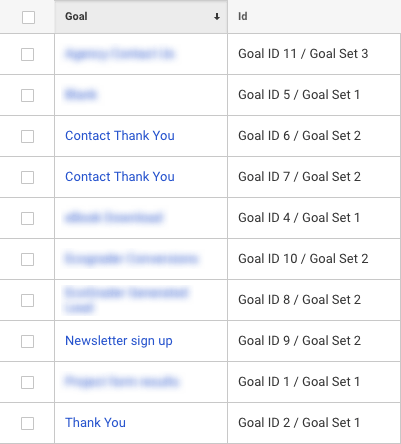Comprehensive List of What Data Is Google Analytics Goals Unable to Track
Comprehensive List of What Data Is Google Analytics Goals Unable to Track
Blog Article
Revealing the Blind Destinations: Understanding What Google Analytics Goals Can not Gauge
In the world of electronic analytics, Google Analytics stands as an effective device for tracking and examining online user interactions. Understanding what Google Analytics goals can not measure is crucial for getting a comprehensive view of individual actions and involvement.
Individual Actions on External Platforms
Comprehending exactly how individuals interact on exterior systems is vital for optimizing on-line approaches. Exterior platforms, such as social networks networks, referral web sites, and on the internet forums, play a substantial duty in driving website traffic to a company's website. By examining individual behavior on these platforms, businesses can get important insights into the effectiveness of their advertising and marketing efforts and the choices of their target market.
One key aspect of individual actions on external platforms is the referral resource. By tracking where the individuals are originating from, organizations can recognize which systems are driving the most traffic to their website. This information can aid firms assign their resources better, concentrating on the systems that generate the most effective outcomes.

Offline Interactions and conversions
Analyzing customer behavior on outside systems offers useful understandings right into online techniques; however, taking into consideration offline conversions and interactions is equally critical for a comprehensive understanding of a company's overall efficiency. Offline conversions, such as in-store purchases or phone questions, play a considerable function in numerous companies' success.

Attribution Beyond Last Click
When delving right into the world of electronic marketing analytics, it becomes vital to look past the single touchpoint of the last click for a much more comprehensive understanding of acknowledgment. While Google Analytics offers important insights right into individual habits, counting only on last-click acknowledgment can be restricting - what data is google analytics goals unable to track. Attribution designs that surpass the last click offer an extra nuanced sight of the client journey, thinking about all the touchpoints that bring about a conversion
Attribution beyond the last click enables online marketers to designate credit to numerous communications along the conversion course, providing a clearer photo of the effectiveness of various advertising and marketing networks. By checking out multi-touch attribution designs such as straight, time degeneration, or position-based acknowledgment, services can much better designate their advertising spending plans and optimize their techniques for maximum effect.
Comprehending the influence of each touchpoint in the conversion process is vital for making informed decisions and taking full advantage of ROI. By welcoming attribution past the last click, businesses can gain deeper insights into client actions and tailor their advertising and marketing initiatives more effectively.
Cross-Device and Cross-Browser Monitoring

In a similar way, view publisher site cross-browser tracking matches cross-device monitoring by capturing individual actions as they change between different internet internet browsers. Understanding just how users communicate with sites on different web browsers can help marketing professionals enhance their on the internet experiences to ensure consistency and functionality across different platforms.
Qualitative Data and User Intent
Comprehending individual intent with qualitative data evaluation is crucial for establishing targeted electronic marketing methods that resonate with the needs and choices of the target audience. Qualitative information provides insights right into the 'why' behind user activities, clarifying motivations, feelings, and preferences that measurable data alone can not catch. By assessing customer feedback, comments, and communications, marketing professionals can discover useful information about individual intent, permitting them to tailor their messaging, content, and offerings to much better align with what their audience is seeking.
Qualitative data likewise helps in understanding the context in which users engage with a website or application. This contextual understanding makes it possible for online marketers to produce more tailored and pertinent experiences, inevitably driving greater involvement and conversion prices. By delving into user intent through qualitative information analysis, businesses can gain a deeper understanding of their target market, causing much more effective advertising approaches that meet customers' expectations and requirements.
Final Thought
In final thought, Google Analytics goals have limitations in gauging user habits on exterior systems, offline conversions, attribution past last click, cross-device and cross-browser monitoring, and qualitative data connected to user intent. what data is google analytics goals unable to track. It is essential for companies to be familiar with these blind places in order to supplement their data analysis with various other tools and techniques to obtain an extra extensive understanding of their audience and enhance their general electronic marketing approaches
By evaluating individual actions on these systems, services can get important insights right into the performance of their advertising and marketing initiatives and the choices of their target use this link audience.
Examining individual actions on external platforms supplies valuable insights right into on-line techniques; however, thinking about offline conversions and communications is similarly vital for a thorough understanding of a business's total performance.In electronic advertising and marketing analytics, relocating beyond last-click attribution to check out cross-device and cross-browser monitoring is vital for gaining a holistic understanding of individual interactions across various platforms and tools. By analyzing individual comments, comments, and interactions, marketers can discover valuable information concerning user intent, permitting them to tailor their messaging, content, and offerings to much better line up with what their audience is looking for.
By diving right into customer intent with qualitative data evaluation, services can get a much deeper understanding of their target audience, leading to a lot more efficient advertising and marketing techniques that satisfy users' assumptions and needs.
Report this page